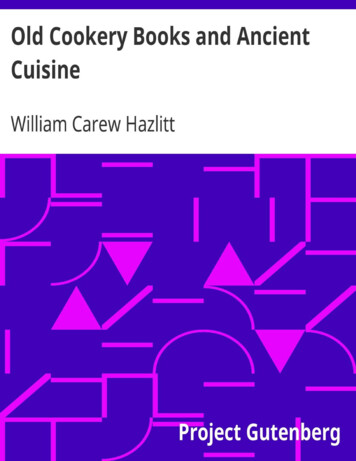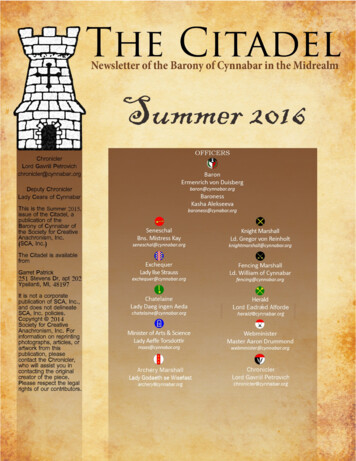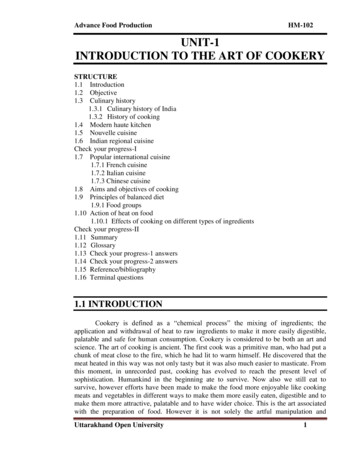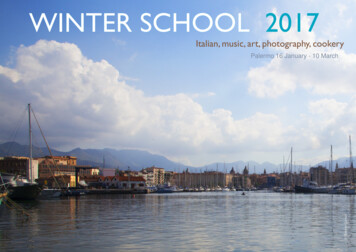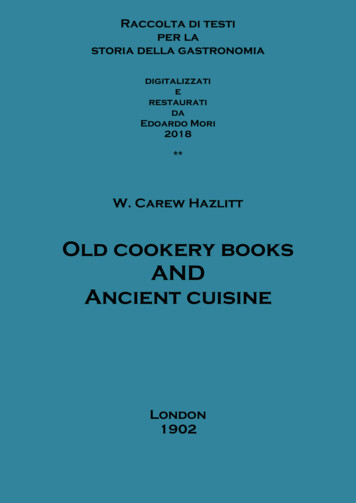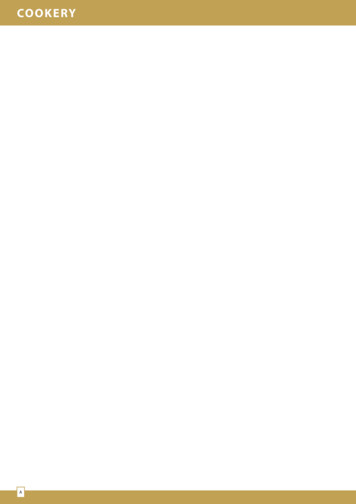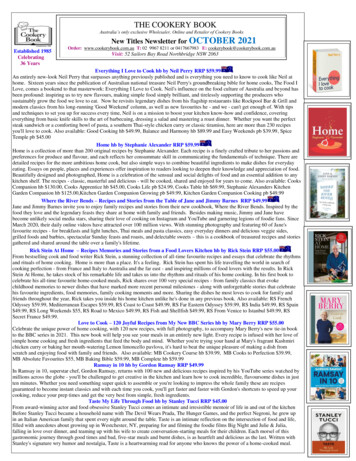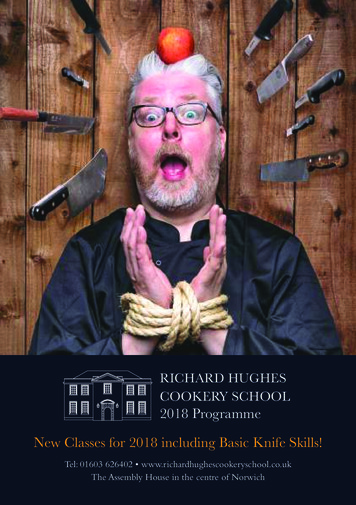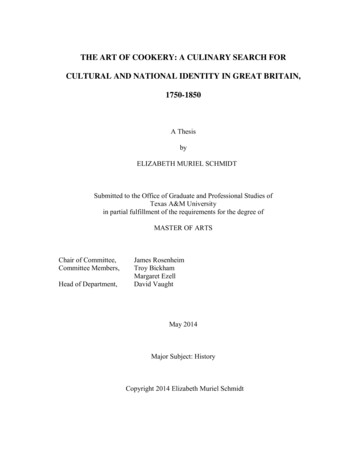
Transcription
THE ART OF COOKERY: A CULINARY SEARCH FORCULTURAL AND NATIONAL IDENTITY IN GREAT BRITAIN,1750-1850A ThesisbyELIZABETH MURIEL SCHMIDTSubmitted to the Office of Graduate and Professional Studies ofTexas A&M Universityin partial fulfillment of the requirements for the degree ofMASTER OF ARTSChair of Committee,Committee Members,Head of Department,James RosenheimTroy BickhamMargaret EzellDavid VaughtMay 2014Major Subject: HistoryCopyright 2014 Elizabeth Muriel Schmidt
ABSTRACTThis thesis discusses how published cookbooks reflect the complicated attitudestoward identity in Great Britain between 1750 and 1850. Focusing on cookbooksproduced as commercial products, we are able to see how gender, national, and regionalidentity was expressed through the introductory pages of a cookbook as well as therecipes that were included. The gendered differences in professional training in Britainresulted in two very different categories of published cookbooks. Male-authored bookswere more appreciative of foreign cuisine, since these authors had technical training inFrance’s nouvelle cuisine. Since women most often gained their knowledge of cookingthrough experiences as housewives or housekeepers, the female-authored cookbooksmore overtly expressed the development of a British national identity. This contributedto the overall trend of anti-French sentiment into the nineteenth century throughcookbook introductions and the exclusion of French recipes, especially as Anglo-Frenchtensions reached high points during this period. A paradox existed as the middlingclasses expressed loyalty to the nation while also conforming to the current fashion ofFrench cuisine. Within the culinary world authors tried to satisfy the middle class byincluding French recipes in their cookbooks while also touting their loyalty to Britainand their preference for “British” cuisine.However, even though nationalistic sentiment increased during periods of intensecommercial and political competition with France, regional distinctions neverdisappeared from the British Isles. This project shows that although a unique “British”ii
identity was forming during the eighteenth and nineteenth century, British subjectsretained regional distinctions such as Scottish, Irish and Welsh. Published cookbooksshow both a decrease in French recipes and an increase in regionally distinctive recipesover the course of a century. By the end of the Napoleonic Wars, French cuisine hadbeen equated with expense and ostentation, gaining a very negative view in the eyes ofcookbook authors. At the same time though, recipes reflected distinct regionalinfluences, illustrating the importance of maintain cultural distinctions. Rather than ahomogenization of British culture, or the conflation of “English” and “British,” thevarious cultures within Great Britain maintained their importance in the eyes of thepeople.iii
TABLE OF CONTENTSPageABSTRACT . iiTABLE OF CONTENTS . ivCHAPTER I INTRODUCTION . 1CHAPTER II BROTHER AND SISTER COOKS: GENDER ANDPROFESSIONAL IDENTITY . 16Nouvelle Cuisine and Social Hierarchies in Britain . 18The “Professional” History of Cuisine and Cookbooks . 25“Let us introduce ourselves ” . 33Female-authored vs. Male-authored Texts . 40CHAPTER III BRITISH OR JUST ANTI-FRENCH? CREATING ANATIONAL IDENTITY . 51The Basis of Loyalty . 54Keeping the Audience in Mind . 62Criticism of the French . 65Quantifying French Recipes . 73Anglicizing Recipes . 78CHAPTER IV ENGLISH OR BRITISH? THE IMPORTANCE OFREGIONAL DISTINCTIONS . 85Historical Context . 92Language of the Introductions . 96Regional Identifiers in Recipe Titles . 103Subscriber Publishing . 110CHAPTER V CONCLUSION . 115BIBLIOGRAPHY . 123APPENDIX . 129iv
CHAPTER IINTRODUCTIONBetween 1750 and 1850 in Great Britain cookbooks were designed to make thelives of housewives, housekeepers, and cooks easier. As author Hannah Glasse phrasedit, the goal of the books were “to improve the Servants, and save the Ladies a great dealof Trouble.”1 Beyond their contemporary purpose, cookbooks offer us a look at the thepolitical, economic, and social cultures of Great Britain during the eighteenth andnineteenth century. Analyzing expressions of different ideas through the preparation andconsumption of different food tells us stories of cookery, consumption, economics,politics, societal norms, and much more. It is through these stories that we understandhow identity was shaped and affected at a certain point in time. Using an analysis of howrecipe titles change over time, increases in the use of specific ingredients, how authorsare portrayed, and the language of instruction readers can draw conclusions about howpeople expressed specific identities. In Britain, cookbooks can help us understand thecomplex relationship between gender, nationalism, and regional uniqueness. Thetransition between the eighteenth and nineteenth century encompassed many eventswhich influenced the development of British identity. These include the Seven YearsWar, the American War for Independence, the 1801 Act of Union, and the NapoleonicWars. This thesis will look at twenty six cookbooks currently available to the authorpublished in Great Britain between 1733 and 1817 to discover how cuisine can be used1Hannah Glasse, The Art of Cookery, Made Plain and Easy (London, 1747), ii.1
to help us understand shifts in identity. It will show how the language and presentationof cookbooks evolved over the course of a century, reflecting the changing ways inwhich gender, national, and regional identities were expressed and changed over time.This project answers questions not just about culinary history or food history, butalso about the history of identity during a period in Great Britain when national loyaltywas not always clearly defined. Political fervor was reflected in cookbooks as authorsexpressed opinions about foreign food during times of war and times of peace. Thispatriotic expression was very often affected by the gendered experience of an authorwhich is portrayed in the differences between male- and female-authored cookbooks.Finally, this project will discuss how national identity and regional identity were bothdeveloping at the same time as the people of Great Britain placed importance on bothBritish patriotism and regional distinctions. Beginning as early as the seventeenthcentury cookbooks began to evolve from a book of ideas shared amongst professionalsto a book of instructions for amateurs. The world of cuisine had been dominated byFrench innovation, reflected in many of the published cookbooks of the seventeenth andeighteenth centuries. Around 1750 heightened tensions between France and Britaincaused a shift in how French cuisine was viewed in published cookbooks: fromfashionable to extravagant and unnecessary. Although authors began to use theirpublished works to make their negative opinions known regarding the French, as HannahGlasse did in the first edition of her book The Art of Cookery in 1747, French recipesnever disappeared from British cookery books. There were, however, often subtlenegative references to the expense and extravagance of French cuisine in comparison to2
British cuisine. Even during periods of heightened conflict with France, however,cookbooks also reflected differences between the food of the different British regions.These distinctions tell us that even when “British” patriotism was vital to the politicalsuccess of the nation, the cultural differences of Britain’s various regions were neverforgotten.Intersections between food and identity are important to find because food is, atits core, essential to human life. Although food is something that everyone has incommon, it also serves as a marker of social distinction equally for those who prepare it,who write about it, and who consume it. The content of a cookbook, includingintroductions, instructions, and recipe titles, gives us information about how food couldbe used to portray distinctions between social classes. Beginning as early as the sixteenthcentury, “the art of cookery” began to dominate published cookbooks as the great chefsmarketed themselves as artists. While food had historically been a medium throughwhich one can entertain and portray power, it was around this time that cookbooks beganto shift from being treatises on the scientific benefits of certain foods to emphasizing theartistry behind cuisine. Cookbooks transformed from a guide to basic survival with anemphasis on health and appetite to a manual on how to prepare and present food in anartistic way; the more extravagant and ostentatious the display, the more wealth andsocial power was displayed. While there has been significant scholarship in the fields ofhistory and anthropology on the role of food systems in society, little work has beendone on how cuisine played a part in social and political culture. Culinary histories of3
France have been written but we have yet to find a work that significantly addresses howcuisine in Britain was used to express social and political identities.At the most basic foundation, food is necessary for humans to survive in terms ofnourishment. However, each culture has approached how that nourishment takes placedifferently, with the development of specific national cuisines based on what is availableto eat. As empires expanded, cuisine in Europe became more and more diverse with theinclusion of different foods from abroad. Looking at the changes in recipes over time wecan see how cookbook authors approached food differently as new ingredients andtechniques were introduced. Cookbooks, as expressions of entire culinary systems andnot just food, can also tell us how people lived on levels other than the basic. In additionto the use of local or exotic ingredients, rituals of manners and culinary procedures canrepresent the existence of social hierarchies and were used to show hospitality andpower. Identifying how different levels of society use rituals of eating to convey ideassuch as power, wealth, and sophistication allows us to understand how food wasinfluential in creating identities. Each section of this thesis deals with a specific type ofidentity, beginning by showing that the gender of an author can affect the content of acookbook by emphasizing particular aspects of their training and professionalbackground. The first chapter will show that men, who trained under professional chefsmost often stemming from Parisian food guilds, had a very positive opinion of Frenchcuisine. On the other hand, the exclusion of women from these professional circlesmeant that their more traditional training from family members and confined to the homegave them a negative view of French food. The second chapter will use cookbooks to4
show how Anglo-French conflict contributed to national patriotism. Wartime politicalzeal often led people to overlook the cultural differences within Great Britain through amutual dislike of France. A criticism of French cuisine and the Anglicization of Frenchrecipes reflect a desire to create a common British identity in the face of politicaltension. Finally, the thesis will end by showing how regionally specific recipes increasedover time. Cookbook authors were appealing to an audience that placed more emphasison regional distinctions by the time the Napoleonic War ended. The cookbooks serve asa reminder that regionalism shouldn’t be ignored as national patriotism didn’t erase theimportance that was placed on regional differences.When it comes to the history of cuisine in the seventeenth, eighteenth, andnineteenth centuries, we must begin with Claude Lévi-Strauss. In his four volumeanthology on the science of mythology he provided an approach to cultural meaningsbased in cultural anthropology. In relation to food, he showed that food taboos, dinnerrituals and manners are based in cultural myths about contamination and impurity.Furthermore, their histories and foundations differ based on the culture in which theyexist. For example, in The Origin of Table Manners, he writes that Italian influence“extended [the French] category of raw” as Italian cuisine opened French eyes to thepossibility of serving vegetables raw without any dressing.2Serious scholarship about particular kinds of cuisine, and their culturalconnotations, began around the 1980s with culinary histories of France, like Babara2Claude Lévi-Strauss, The Origin of Table Manners (New York: Harper & Row, Publishers, 1978), 478.5
Ketcham Wheaton’s book Savoring the Past. 3 Similar to the fact that the British adoptedFrench cuisine much later than it was developed in France, histories of British cuisinecame later. Because French cuisine was considered to have the greatest influence overwhat we consider modern cuisine, culinary history had to begin with what the French didand how it permeated throughout the world. Wheaton’s book analyzes how Frenchcuisine developed over time between 1300 and 1789, discussing how events in France’spolitical history affected the development and spread of French cuisine to other areas ofEurope. She briefly touches on the influence of French cuisine in Britain when she talksabout French chefs working in British households to add an air of prestige, especiallyafter the Edict of Nantes was revoked in 1685 and Protestant French chefs were forced toleave France, taking their training with them.4 Later books on French cuisine, includingSarah Peterson’s Acquired Taste, also discuss the specific history of French cuisine.These books briefly touch on the impact of French food in Britain but are more generallya culinary history of France specifically. Peterson’s book, published in 1994, specificallydiscusses the medieval and renaissance origins of French cuisine, providing readers witha comprehensive history of how specific ingredients and techniques came to be inFrench cooking.5 In 1995, Stephen Mennel published All Manners of Food, a history ofcuisine in both England and France. His book proves to be mostly a history of Frenchcuisine and its influences, since food in England was so heavily influenced by theFrench. His book does discuss the English cookery book but only to the extent that even3Barbara Ketcham Wheaton, Savoring the Past: The French Kitchen and Table from 1300 to 1789 (NewYork: Scribner, 1983).4Wheaton, Savoring the Past, 160-172.5Sarah T. Peterson, Acquired Taste: The French Origins of Modern Cooking (Ithaca: Cornell UniversityPress, 1994).6
the earliest printed cookery books had French influence.6 Books that have come outspecifically on cookery in England are also very heavy on the side of French cuisine,because of the significant influence. Elisabeth Ayrton, C. Anne Wilson, and KateColquhoun are three authors who have produced works specifically about cuisine inGreat Britain. Ayrton’s book, The Cookery of England published in 1988, is the story ofhow traditional English recipes developed over time.7 Alongside her historical research,Ayrton also provided her readers with several recipes from different periods inEngland’s history. Wilson’s Food and Drink in Britain, published in 1991, is verysimilar to Ayrton’s, discussing specific items in British cookery books.8 Her book has anexpanded geography, as it includes food and drink items from outside of England andcovers Scotland and Ireland as well. Colquhoun, however, took a different approach inher book Taste: The Story of Britain through its Cooking.9 Taste has a more globalapproach, discussing the appearance of new ingredients as Britain’s empire expanded.All three of these books still include discussions of the French influence on Britishcooking. Aside from books discussing specific national cuisines, there are also severalthat discuss food in Europe more generally, like those by Felipe Fernandez-Armesto orKen Albala.106Stephen Mennell, All Manners of Food: Eating and Taste in England and France from the Middle Agesto the Present, (Champaign: University of Illinois Press, 1995), 85.7Elisabeth Ayrton, The Cookery of England (New York: Penguin, 1988).8C. Anne Wilson, Food and Drink in Britain: From the Stone Age to the 19 th Century (Chicago: AcademyPublishers, 1991).9Kate Colquhoun, Taste: The Story of Britain Through Its Cooking (New York: Bloomsbury, 2007).10Felipe Fernandez-Armesto, Near a Thousand Tables: A History of Food (New York: Free Press, 2002);Ken Albala, Food in Early Modern Europe (Westport: Greenwood Press, 2003).7
Books within the field of culinary history also cover whole culinary systems thatsurround the consumption of food. Margaret Visser’s The Rituals of Dinner looks at howthe rituals associated with a meal have developed over time in several parts of the world.11She discusses how different rituals coincide with changes in social hierarchies andactivities in various cultures, and the development of dinner rituals into what we knowtoday. The field also includes works that discuss the history of specific ingredients andtheir connections to world history, such as Sidney Mintz’s Sweetness and Power, orMark Kurlansky’s Salt.12 Connections between food and empire, like Colquhoun’sTaste, are also found within culinary history. Lizzie Collingham’s Curry: A Tale ofCooks and Conquerors discusses how British colonialism in India put into motion thedevelopment of a new “Indian” cuisine based on what the British found appetizing.13Troy Bickham’s article “Eating the Empire” is on a similar topic but discusses theexistence of ingredients and recipes in Britain from the British colonies. Paul Langford’swork on how consumption and the Grand Tour influenced British colonies is alsorelevant to a project like this. Class specific consumption statistics, and the way in whichluxury and food contributed to social standing, helps to understand how class identityaffected the development of a national identity.14The field of food history includes books written by many different types ofothers, some academic and some not. Food essays and memoirs are popular books for11Margaret Visser, The Ritual of Dinner: The Origins, Evolution, Eccentricities, and Meaning of TableManners (New York: Grove Weidenfeld, 1991).12Sidney Mintz, Sweetness and Power: The Place of Sugar in Modern History (New York: PenguinBooks, 1985); Mark Kurlansky, Salt: A World History (New York: Penguin Books, 2002).13Lizzie Collingham, Curry: A Tale of Cooks and Conquerors (New York: Oxford University Press,2002).14Paul Langford, A Polite and Commercial People: England 1727-1783 (Oxford: Clarendon Press, 1989).8
the average reader, often being written by professional chefs or food writers. Althoughbooks of this sort occasionally reference the history of a particular ingredient or type offood, more often than not they are based on the writer’s personal experience. MarkKurlansky’s books Salt: A World History and Cod: A Biography of the Fish thatChanged the World are insightful looks at how a single item of food could affect worldevents. Kurlansky’s lack of professional historical training, however, means that thebooks are generally based on only secondary literature with no primary evidence tosupport the argument. Although these books are not as reliable as those written by atrained academic, they are still worthwhile in that they represent the desire for anunderstanding of how food has had an influence on history.National identity is a topic that many authors have already covered, either generallyor in relation to a specific place. Benedict Anderson’s Imagined Communities is one ofthe most well-known books on nationalism and has sparked plenty of debate within thefield.15 In terms of British nationalism specifically, many authors, such as Linda Colleyand Robert Tombs, have produced works that discuss how enmity toward the Frenchcreated an identity that was specifically “British,” eliminating a dependence on regionalidentities.16 While books such as these touch briefly on the existence of French cuisinewithin Great Britain, they do not go into great detail on how this affected popularopinion of either France or Britain. Intersections between the culinary histories andhistories of British nationalism do not really exist on their own. That is where works15Benedict Anderson, Imagined Communities: Reflections on the Origins and Spread of Nationalism(New York: Verso, 2006).16Linda Colley, Britons: Forging the Nation 1707-1837 (New Haven: Yale University Press, 1992);Isabelle and Robert Tombs, That Sweet Enemy: The French and the British from the Sun King to thePresent (London: William Heinemann, 2006).9
such as this thesis fit in, with a discussion on how changes in cookbooks reflect changesin both British national and regional identity.This thesis examines and analyzes twenty-six first editions of differentcookbooks published in Great Britain. The sample represents areas of Great Britainoutside of London as well both female and male authors. The specific dates that thesample covers is 1733 to 1817, and uses only first editions when available. The decisionto avoid later editions was made in order to present each cookbook on an equal playingfield, focusing on how the text appeared originally rather than including later publicationhistory that altered its original state. For a similar reason, the study focuses only onprinted cookbooks instead of including manuscripts because the analysis covers whatwas marketed to a public audience, not a private compilation of recipes or somethingthat was circulated amongst a select group of people. What we are interested in here isthe commercially published books that were available to the average consumer ineighteenth and nineteenth century Britain rather than handwritten manuscripts passedbetween family and friends. The sample is fairly evenly spread over the time periodstudied although the representation of male and female authors is less even. Thecookbooks looked at here include eleven “male-authored” texts and fifteen “femaleauthored” texts. This skewed distribution is, however, representative of the period since“female-authored” texts appeared to be more marketable beginning around 1750.Different from many other genres of books, cookbooks present a problem when itcomes to the identities of the authors. As cookbooks are compilations of someone’sculinary experience, original authorship of specific recipes is almost impossible to10
determine and the identification of these authors is not necessary for a study of this sort.The analysis focuses on whether specific recipes are included in the book and how theyare labeled rather than their origin. Furthermore, the name of the author on the title pageis not always accurate. Occasionally, publishers would have invented a persona toassociate with their cookbook, or they could have taken the book from its original authorand expanded on it later without his or her knowledge, yet still using the name of theoriginal author. However, this thesis will focus on the identity of the author that isportrayed, specifically, whether that persona is male or female. For the purposes of thisstudy, texts are either “male-authored” or “female-authored” based on how they arepresented to their readership and not necessarily the historical record. Informationregarding the identities of various authors will focus on whether they were technicallytrained to cook or whether they learned by experience; i.e., the majority of male authorsbuild on their qualifications as a professional chef while female authors were apparentlymore marketable if they had learned to cook through work experience as a housekeeper.Because of this distinction, historical identities of the authors are not as important as thepublic face of the author in the books for this study.The type of data collected from these cookbooks falls into three categories: styleand prose, recipe titles, and ingredients. The style and prose data encompasses thelanguage used in both the introduction and in the instructions included with the recipes.This language reflects the gender identity and experiential background of the author. Therecipe titles reflect where recipes originated and occasionally to whom they areattributed. The change in titles over time indicates how foreign cuisine was presented to11
the general public at specific points in time. Combined with the techniques included inthe recipe instructions, it can also give hints as to how titles attributed to one kind ofcuisine, for example a French fricasseé, were often not reflective of the true technique.The final category helps us to understand what ingredients may have been commonplacein a typical British household. Instructions accompanying certain ingredients, such as“obtain some Jamaica pepper,” reveal that an author expected readers to use aningredient but did not necessarily expect them to have it in their kitchen already, andassumed they could obtain it. Comparing the existence of these ingredients in thecookbooks to advertisements in local papers about the availability of such ingredientswould lead to a better understanding of when certain spices, fruits, etc. becamecommonplace in British markets.The first chapter will deal with how professional identity in the world of foodwas extremely gendered, as both experience and the sex of the author affected how theyapproached their audience and what they included in their books. I will first look at thehistory of cuisine and published cookbooks, highlighting how the vocabulary andexperiences within the food profession were determined by gender stereotypes in GreatBritain. Then, this chapter will deal specifically with how an author’s background andsex dictated the content of the cookbook. An author’s background generally affectedhow much influence French cuisine had on recipes within their books, as men were morelikely to have been trained professionally by master cooks who specialized in Frenchcuisine. Food and drink guilds in Britain were most often found in the large urban areasand had similar structures to other craft-guilds that existed. Masters hired apprentices to12
teach them skills needed to be successful in food and drink markets. As French cooksleft France for various reasons many of them looked for employment in Great Britain.Often they were able to find a place within the food guilds that existed within Britain,training future British cooks in the art of French cuisine. For the most part, guild statutesprecluded entry by women and so female cooks were most often trained by their mothersor grandmothers who were more familiar with traditional simpler British cuisine.17The second chapter illustrates the criticism of French cuisine that existed withinpublished cookbooks, detailing how this criticism bolstered British nationalism. Francehad an unmistakable influence on the social atmosphere of Great Britain as French food,clothing, and manners were considered highly fashionable. However, a desire to appearfashionable was often affected by political struggles that were anti-French. Thecookbooks show a shift from a desire to be “fashionable” to the ideal household as“elegant,” terms that became associated with France and Britain respectively. “Fashion”came to represent French extravagance and expense while “elegance” was sophisticationand frugality. This chapter will first analyze the paradox that occurred between socialand political opinions of the French, and how this is expressed through the cookbooks. Itwill also consider how imperial connections affected the content of the cookbooks andbolstered a view of “Britishness” that was increasingly globalized.17For more information regarding craft-guilds in England, see: Patrick Wallis, “Apprenticeship andTraining in Premodern England,” The Journal of Economic History, 68:3 (2008), pp. 832-861.; GaryRichardson, “A Tale of Two Theories: Monopolies and Craft Guilds in Medieval England and ModernImagination,” Journal of the History of Economic Thought 23:2 (2001), pp 217-242.; Clare Crowston,“Women, Gender, and Guilds in Early Modern Europe: An Overview of Recent Research,” IRSH, 53(2008), pp. 19-44.13
The final chapter will discuss how cookbooks reflect the tendency to conflate“English” with “British” and the tensions between Welsh, Scottish, Irish and Englishpopulations. Even as the people of Great Britain were creating a “British” identity,regio
never disappeared from British cookery books. There were, however, often subtle negative references to the expense and extravagance of French cuisine in comparison to . category of raw" as Italian cuisine opened French eyes to the possibility of serving vegetables raw without any dressing.2 Serious scholarship about particular kinds of .
